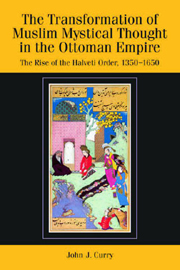 The Transformation of Muslim Mystical Thought in the Ottoman Empire
The Transformation of Muslim Mystical Thought in the Ottoman Empire from PART II - THE EVOLUTION OF A HALVETİ SUB-BRANCH: THE LIFE AND CAREER OF ŞAcBÂN-I VELİ AND HIS FOLLOWERS IN THE KASTAMONU REGION
Published online by Cambridge University Press: 12 September 2012
For the population of the Ottoman Empire, the death of the long lived Sultan Süleymân, the only ruler most had known, ushered in a period of growing instability. The impending arrival of the Muslim millennium in 1000/1591, and the political and economic tensions unleashed by the Ottoman Empire's growing pains only added to the social and religious tensions of the age. For the nascent following of the Şacbâniye order in Kastamonu, the uncertainty was doubly pronounced given the illness and death of Şacbân-ı Veli shortly after Süleymân. Despite these challenges, the core membership of the order rallied around its leaders and principles, and a disparate group of several successors to Şacbân's legacy emerged who succeeded in maintaining his legacy. These figures had more direct connections with Şacbân's hagiographer, cÖmer el-Fuɔâdî, and their relationships with him developed on a much more personal level than Fuɔâdî could claim with regard to Şacbân himself. Still, a careful reading of Fuɔâdî's narrative of the post-Şacbân era suggests that by the time he acceded to the leadership of the Şacbâniye in 1012/1604, the order's development still remained uneven in character, and the legacy of its founder was under threat as it receded into an increasingly distant past.
To save this book to your Kindle, first ensure no-reply@cambridge.org is added to your Approved Personal Document E-mail List under your Personal Document Settings on the Manage Your Content and Devices page of your Amazon account. Then enter the ‘name’ part of your Kindle email address below. Find out more about saving to your Kindle.
Note you can select to save to either the @free.kindle.com or @kindle.com variations. ‘@free.kindle.com’ emails are free but can only be saved to your device when it is connected to wi-fi. ‘@kindle.com’ emails can be delivered even when you are not connected to wi-fi, but note that service fees apply.
Find out more about the Kindle Personal Document Service.
To save content items to your account, please confirm that you agree to abide by our usage policies. If this is the first time you use this feature, you will be asked to authorise Cambridge Core to connect with your account. Find out more about saving content to Dropbox.
To save content items to your account, please confirm that you agree to abide by our usage policies. If this is the first time you use this feature, you will be asked to authorise Cambridge Core to connect with your account. Find out more about saving content to Google Drive.